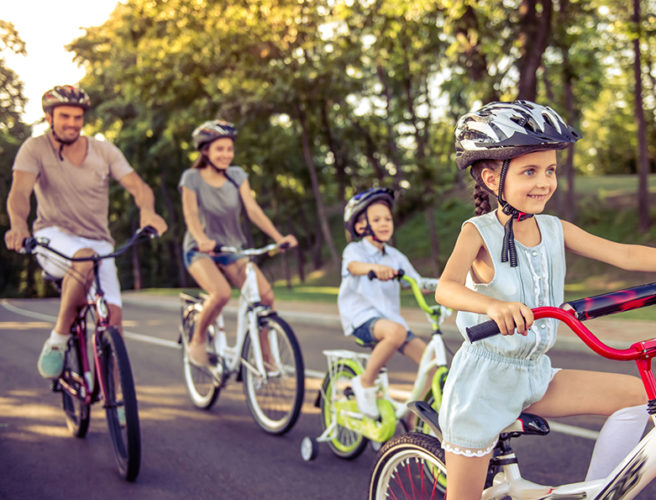
Bicycling is one of the best ways to stay in shape, see the sights, save money on gas and reduce pollution. The benefits are well-known to cycling enthusiasts and local leaders nationwide who have created bike-friendly communities, complete with paths, special bicycle parking areas and other conveniences. National Bike Safety Month in May is just one way we celebrate our love to ride. (See more on that below.)
The Risks
Bicyclists must take extra precautions when they ride. They often share the road with vehicles, which creates a host of hazards, but injuries can happen even on a designated path.
Did you know in 2014, bicycles were associated with more injuries over all age groups than skateboards, trampolines, swimming pools and playground equipment combined? According to Injury Facts 2016, the statistical report on unintentional injuries created by the National Safety Council, 510,905 people were treated in emergency rooms in 2014 after being injured riding a bicycle. The only sport resulting in more injuries overall was basketball, at 522,817. Football was third, at 396,457.
According to Injury Facts, about 1,000 deaths resulted from cyclists colliding with motor vehicles in 2014. With about 80 million bike riders sharing the road with millions of motorized vehicles, the importance of safety precautions in traffic cannot be overstated.
Use Your Head, Protect Your Noggin
Cyclists who wear a helmet reduce their risk of head injury by an estimated 60% and brain injury by 58%. That statistic makes sense when you consider the first body part to fly forward in a collision is usually the head, and with nothing but skin and bone to protect the brain, the results can be fatal.
Helmets must meet federal safety standards and should fit securely. This National Highway Traffic Safety Administration video offers instruction on how to properly fit a helmet.
Follow These Rules to Keep Safe
- Get acquainted with traffic laws; cyclists must follow the same rules as motorists
- Know your bike’s capabilities
- Ride single-file in the direction of traffic, and watch for opening car doors and other hazards
- Use hand signals when turning and use extra care at intersections
- Never hitch onto cars
- Before entering traffic, stop and look left, right, left again and over your shoulder
- Wear bright clothing and ride during the day
- If night riding can’t be avoided, wear reflective clothing
- Make sure the bike is equipped with reflectors on the rear, front, pedals and spokes
- A horn or bell and a rear-view mirror, as well as a bright headlight, also is recommended
May is National Bike Month
During National Bike Month, cycling enthusiasts across the country celebrate the many benefits of cycling. The League of American Bicyclists, which advocates for a “Bicycle Friendly America,” sponsors Bike Month each year. The League’s handy, 32-page National Bike Month Guide has everything you need to plan a Bike Month event in your community, including tons of ideas for activities.
The League’s Ride Smart program also is a great resource for educational videos, classes, tips and other information about bike safety. Learn more about Ride Smart here.
More Resources
Source: National Safety Council


Leave A Comment